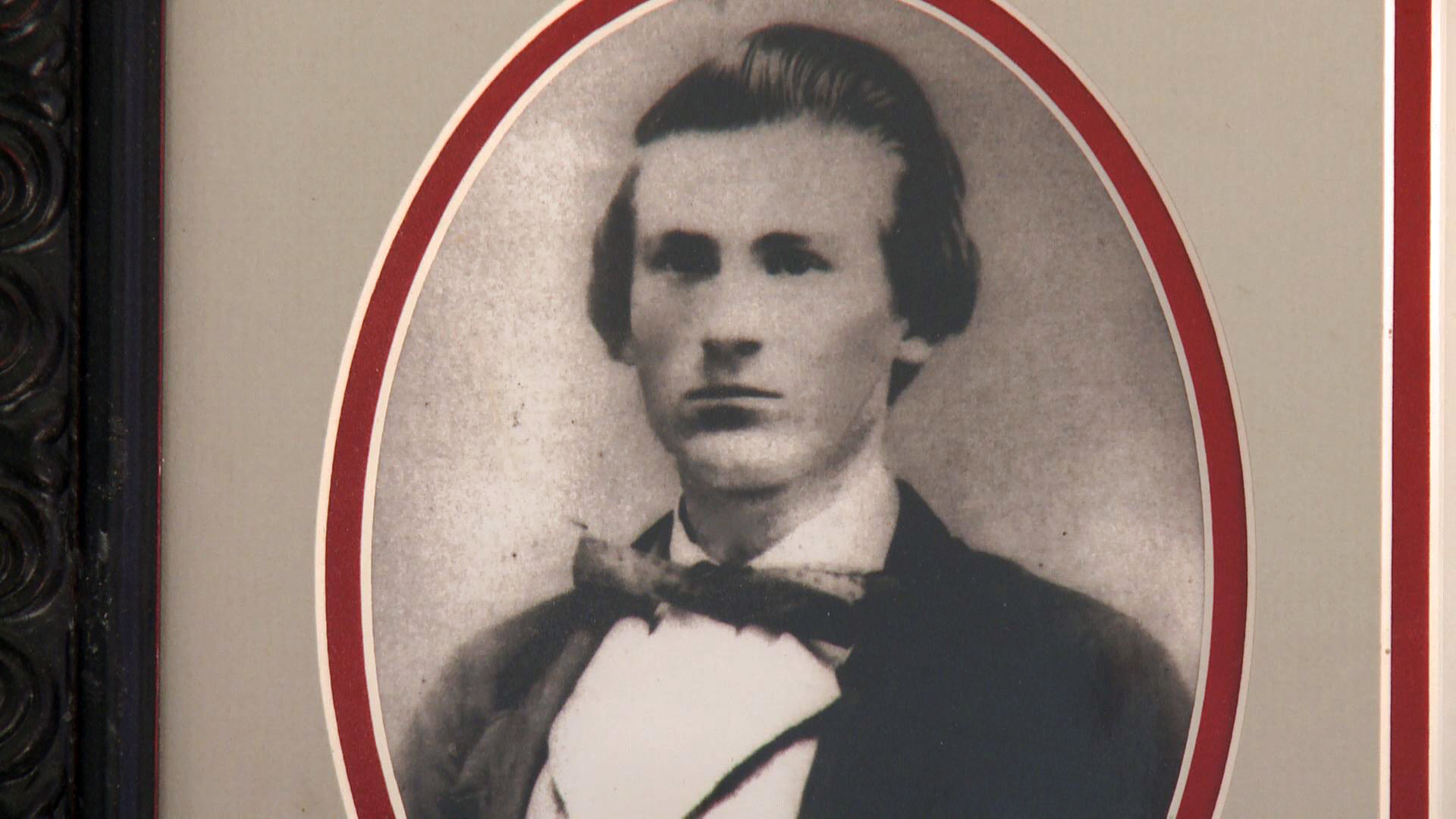(WBIR - Knoxville) Developer Tony Cappiello is cooking up a new life for the historic Baker Peters House in West Knoxville. He's renovating the upstairs of the home for a new restaurant that will feature a piano, cocktails, steaks, and a side-serving of ghost stories.
"This is Abner Baker and he's our ghost. He was a confederate soldier during the Civil War," said Cappiello as he pointed at a portrait of a young man on a fireplace mantel. "From what I've been told, he moves throughout the house. You'd hear the falling of pans in the kitchen and there was no one in the kitchen. The light fixtures would sometimes start swaying. I guess there are bad ghosts and good ghosts. He doesn't seem to be an angry ghost as far as we can tell."
Tales of an apparition named Abner are not what make the house at 9000 Kingston Pike historic. The historic designation comes from the truth behind the tall tales, starting with construction of the home in 1840 by Abner's father, Dr. Harvey Baker.
"Back then that area was rural farmland several miles from Knoxville," said Joan Markel, curator of Civil War exhibits at the McClung Museum. "It was way out there, but the Bakers were not isolated. Dr. Baker's brother had a house nearby and they both lived right on Kingston Pike. Kingston Pike was the major east-west thoroughfare."
In June 1863, Abner Baker was away at war and fighting for the confederacy. Although much of East Tennessee held allegiance to the Union, the rebels controlled the City of Knoxville and Dr. Harvey Baker supported them. At that point, the area was about to have its first brush with actual Civil War combat with an incoming raid of 1,500 Union cavalry from Kentucky hellbent on busting up bridges and railroads that supplied the confederates.
The Union raid rolled toward Knoxville on the road directly in front of Dr. Baker's house. Dr. Baker grabbed his gun, got on his horse, and planned to head to Knoxville to warn the rebels and help defend the city. One account says he was spotted mounting up and did not get far before he was stopped.
"There was an interaction that did not go well for him [Dr. Baker] with the Union cavalry," said Markel.
We don't know shot first, but one account from a neighbor said Dr. Baker and the Union soldier who stopped him both fired to no effect. Dr. Baker ran back to his house and barricaded himself in the upstairs bedroom with family members, including his wife. Federal troops went in for the kill.
"A soldier shot through the bedroom door and killed Dr. Baker," said Cappiello. "The original bedroom door is now downstairs at the office of the dentist who owns the Baker Peters house. "You can see two bullet holes where the soldier shot through it."
There are conflicting accounts as to whether Dr. Baker was mortally wounded by the shots that went through the door or if he was killed shortly after. Either way, he was killed at the home and is one of the first official casualties of the Civil War in Knox County.
"I don't know if we can prove he was the very first person killed in the raid, but we can say Dr. Baker was one of the first," said Markel. "We have a big beautiful map from November 1863 that was a reconnaissance map for the Union campaign in Knoxville. If you trace the map down Kingston Pike, you get to the Baker Peters house and it is labeled 'Widow Baker.' That's referring to the fact Dr. Baker was killed earlier that year in June 1863, so it's already on very early maps."
Dr. Baker's death was controversial and the Federal forces investigated the incident.
"This man was surrounded by his family, he was in his own home, and he was shot. I think the involvement of the family made that death more prominent than the other deaths that are an expected part of war. But the Union troops were exonerated of any wrongdoing and Dr. Baker's death was deemed a casualty of war."
While the Union called the death a casualty, those with allegiance to the confederacy called it murder.
In 1865, the Civil War ended and 22-year-old Abner Baker returned to Tennessee. The Union forces not only defeated him on the battlefield, they killed his father at home.
"Is the son going to feel hostility because his father's gunned down by Union cavalry? Absolutely," said Markel.
Things exploded in Downtown Knoxville in September 1865 when Abner Baker got into a fight with Will Hall, a 24-year-old Union veteran who worked as a clerk at the courthouse. The fight ended with Abner shooting Hall in the head.
"There are different partisan versions of the story about how the fight started, but the fact of it was Abner pulled a gun and killed a guy. He was immediately arrested and put in jail," said Markel.
Word quickly spread about the rebel killer being held behind bars. That night the downtown fire bell rang, but there was no fire. The bell was a death knell that signaled an angry mob to come together and storm the jail.
"That night, Abner is broken out of jail and hanged from a tree," said Markel.
Abner Baker never got a chance to go to trial, but partisan newspapers argued the case and the motives. The Knoxville Whig said Baker and Hall had "an old grudge" from before the war when Baker pulled a gun on Hall. Confederate sympathizers claimed Abner acted in self-defense because he was being beaten with a cane by the bigger and stronger Hall.
No articles at the time say anything about revenge being a motive, but the notion of vengeance worked its way into the story more than a century later when a book published in 1976 claimed Abner killed Hall for his involvement in Dr. Baker's death. Markel says there is no proof Hall was involved in the death of Abner's father.
"Other than being a Unionist supporter in general, I've never seen anything about this man downtown having anything to do with Dr. Baker's death. Is there hostility between these two guys just after the war, remembering which side they were on? I believe so," said Markel.
Some blatantly inaccurate versions of the Bakers' story have become solidified in many places in recent years. Specifically, a historic marker in front of the Baker Peters House claims Hall was a postmaster who informed Union forces that Dr. Baker was using the home as a make-shift hospital to treat wounded confederate troops. The sign says Union forces came to the house to arrest Dr. Baker and fatally shot him in 1864. The sign then says Abner Baker murdered Hall in retaliation for his role in the death of Dr. Baker. Again, the truth is Dr. Baker was killed in June 1863, Hall was not a postmaster, and no newspaper accounts at the time mention Dr. Baker's death as a motive in the shooting death of Hall.
Whatever the motive, the shooting and swift vigilante justice by an angry mob made newspapers as far away as Boston. Panorama photographs of Knoxville from 1865 include numbered labels of significant landmarks, including "the tragic tree on which Confederate Abner Baker was hanged."
Although confederate sympathizers in the community could not stop Abner Baker's lynching, they were able to give him an honorable burial downtown.
"Even though the First Presbyterian Cemetery was technically full, they found a place for Abner and put up a monument," said Markel.
Since his death, Abner Baker's legend has grown. In the 1920s, the local chapter of the United Daughters of the Confederacy put a marker in front of the Baker Peters House that calls Abner "a martyr for manliness and personal rights." The group also made Abner its namesake as the Abner Baker Chapter of the United Daughters of the Confederacy.
Abner's spirit also grew into frightening folklore, with tales of his ghost haunting the spot where he was lynched as well as the First Presbyterian's graveyard where he is buried. Of course, there are also the stories of Abner's ghost at the house where he grew up and his father was killed.
"It's a story about vengeance. It's a story about ghosts. It's truly both a tragedy and a wonderful story built upon legend," said Cappiello.
Cappiello said renovations should wrap up later this year and the restaurant will open to the public in early-2016. He said the menu will pay homage to the original owners of the house and the apparition who still lingers. One item will be a "Baker's dozen" oysters.
"It's a play on words with Abner's last name and the old baker's dozen, which is the unlucky number 13. When you order a dozen oysters, you'll actually get 13 oysters. The 13th oyster is for the ghost of Abner Baker, so you'll eat that one at your own risk," grinned Cappiello.
While the tall tales are entertaining, they also include pearls of truth that live on with the Baker Peters House.
"The Union army marched right past that house, there are bullet holes in the door, and that's why saving a house like that is so important. These houses are things that are solid brick-and-mortar, literally, connections to the past," said Markel.
The Baker Peters House survived much more than the Civil War. It was nearly destroyed by urban development in 1989. Phillips Petroleum planned to tear the house down to build a gas station when hundreds of people protested, pressured city council, and ultimately convinced the company to compromise. The gas station was built in the surrounding yard while the house was spared. The house was purchased by a dentist who sought to save the home. He still uses the downstairs as his dental office today and has rented the remainder of the house to various businesses. The rest of the house has previously been home to a jazz club and several restaurants, including one in the 1990s named "Abner's Attic."


